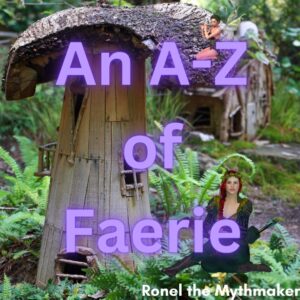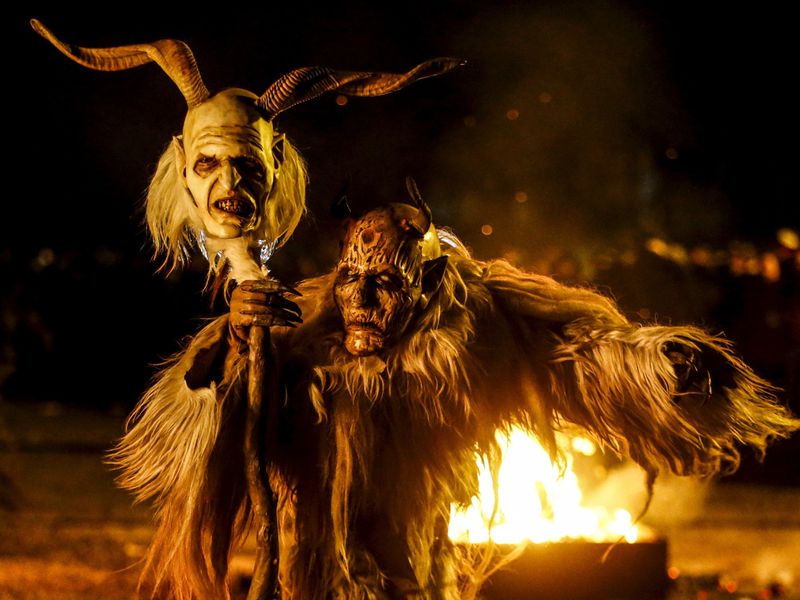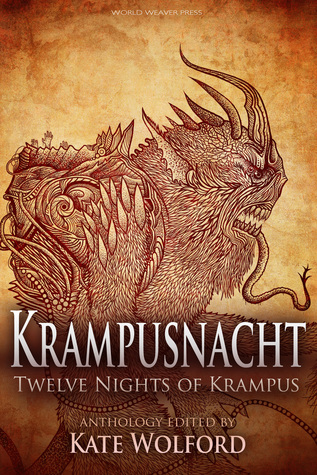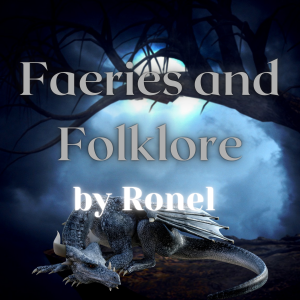Y is for Yule.
Yule n archaic term for Christmas
Oxford English Dictionary


The Yule season is a time of rebirth and joy. But there are darker stories in folklore; creatures that make even the delinquents behave. Krampus is one of those creatures.
Folklore
Christmas in Ritual and Tradition by Clement A. Miles [1912]
On December 6 we reach the most distinctive children’s festival of the whole year, St. Nicholas’s Day. In Lower Austria the saint is followed by a similar figure called Krampus or Grampus.
The Old Magic of Christmas: Yuletide Traditions for the Darkest Days of the Year by Linda Raedisch
This time, the footsteps are accompanied by the clanking of bells and the rattling of chains as well as the whistle and crack of the birch rod as it slashed through the air. There are monsters out there, and they are just warming up for their first performance.
But fear is alive and well among Czech children on the eve of St. Nicholas Day, known to them as Angels and Devils Night. The star of Angels and Devils Night is a horned demon named Čert who looks rather like an upright goat but has the face and hands of a man, and whose foot-long scarlet tongue… his writs linked by iron chains, he carries a birch switch in one hand and an empty basket on his back. Thanks to Čert, Czech children do not have to wait until Christmas Eve to get what’s coming to them; as the sun sets on December 5, they face the very real possibility that they will be carried off to Hell in Čert’s basked that very night.
If Čert, or Krampus as he is known in Austria and parts of Germany, were allowed to roam freely, we would all be lost.
*More can be read in the book.
The Krampus and the Old, Dark Christmas: Roots and Rebirth of the Folkloric Devil by Al Ridenour
Nicholas Meets the Perchten
Gradually this practice of Nicholas rewarding good study and piety spread from environments under influence of the Church and urban aristocracy to more rural areas. Once there, the saint’s character tended to be colored by existing rural folklore and customs. The Alpine regions it entered were home to a sort of folk-Catholicism mingled with an indigenous pagan folklore. Dominating this landscape were ambivalent, often-devilish mountain spirits known as the Perchten (singular: “Percht“). Masqueraders posing as these figures were part of rowdy costumed processions first explicitly mentioned in 17th-century documents. Probably quite similar to the earliest Krampus runs, the Perchtenlauf was regarded with suspicion by Church and civil authorities as a custom of the peasant class, one that threatened riot and occasionally resulted in violence.
As the Perchtenlauf was transformed into the Krampuslauf and hybridized with the Nicholas play, the wild Percht was reshaped as the Krampus — chained and subjugated to Nicholas, and thus brough under the control of ecclesiastic narrative and civil authority.
*More can be read in the book.
Further Reading:
- Krampus
- The Dark Side of Christmas
- Santa’s Horned Helper
- Krampus
- Krampus: The Christmas Devil of Alpine Folklore
Folklore in a Nutshell by Ronel
Though Krampus is mostly found in Alpine folklore, his origins go back to Norse mythology. As the grandson of Loki, mischief is what you expect – with a dose of fear.
Krampus (or Prechten or Tuifl) is the son of the Norse goddess, Hel. He has been linked in folklore with St. Nikolaus (Father Christmas) as both arrive around December 5th. St. Nikolaus fill the shoes of good children with gifts and bad children’s shoes with a rod. Krampus, however, beats naughty children with the birch bundle he carries with him before he stuffs them into his basket and carries them off (either to eat them or to the underworld). He is also said to leave behind a lump of coal.
Krampus has a monstrous look: horns, matted dark hair covering his body, cloven hooves, fangs, claws – the stuff of nightmares. Besides his birch sticks, he also has a chain and bells to complete his look.
Krampus in Modern Culture
Grimm
Krampus (KRAAM-puus; O.H.Ger. Krampen “claw”) is an anti-Santa Wesen resembling a wild sheep that appeared in “Twelve Days of Krampus”. According to legend, he appears before Christmas and kidnaps naughty children who he keeps up in the tallest tree at the tallest spot. He does this with the intention of eating the children and then disappearing for a whole year.
Krampus hunts naughty children and adolescents, admonishing them for their bad behavior before beating them with a wooden switch and stuffing them in a large sack, leaving a large lump of coal behind at the abduction site. This coal is natively found in a mine on the highest arctic reach, near the North Pole. Upon abducting the children, Krampus hangs them from baskets like ornaments in the tallest tree in the tallest spot on the land with the intention of devouring them on the night of the Winter Solstice.
As Krampus exists for only three weeks out of every year and his human self is completely unaware of his Wesen self, Krampus has no culture of his own and is thought to be mythical even by other Wesen. The relationship between the Wesen and human form is described as a “Jekyll and Hyde-like” relationship, with the human side unaware of its true nature and the Wesen side acting completely on its own accord.
Krampus Parade
Lienz’ annual Krampus Parade, also known as Perchtenlauf or Klaubaufe, resurrects a centuries-old tradition: Young men in town dress up as the mythical creature and parade through the streets in an ancient pagan ritual meant to disperse winter’s ghosts. They march dressed in fur suits and carved wooden masks and carrying cowbells. The tradition—also known as the Krampuslauf, or Krampus Run—is having a resurgence throughout Austria, Germany, Slovenia, Hungary and the Czech Republic, and has gained recognition in the United States.
Krampusnacht: Twelve Nights of Krampus
For bad children, a lump of coal from Santa is positively light punishment when Krampus is ready and waiting to beat them with a stick, wrap them in chains, and drag them down to hell–all with St. Nick’s encouragement and approval.
Krampusnacht holds within its pages twelve tales of Krampus triumphant, usurped, befriended, and much more. From evil children (and adults) who get their due, to those who pull one over on the ancient “Christmas Devil.” From historic Europe, to the North Pole, to present day American suburbia, these all new stories embark on a revitalization of the Krampus tradition.
Whether you choose to read Krampusnacht over twelve dark and scary nights or devour it in one nacht of joy and terror, these stories are sure to add chills and magic to any winter’s reading.
Krampus in My Writing
Origin of the Fae: Krampus
Krampus is the son of Hel, Goddess of the Underworld. He goes to the Mortal Realm during Yuletide to whip naughty children with a bundle of birch twigs or to give them a lump of coal. He works with the gift-giving witches Befana and Bertha.
He loses his power during the Winter Solstice and leaves the mortal realm soon after.
He has dark fur, twisted horns, reddish eyes and a forked tongue. His claws can rip through anything. His cloven hoofs can be heard in the dark, as can the chains he is covered with.
When no offerings are left during Samhain to appease him, he will abduct and even eat the naughty children instead of whipping them into shape. The Yule Riders will be released to find him when this happens. Sometimes he will weave baskets to keep the children in, other times he’ll throw them in a bag.
Krampus, like the Yule Riders, knows exactly what is in the hearts of mortals.
See him in action:
Unseen (Faery Tales #2)

A yelp rent the air. Anja’s heart went cold. She ran. Krampus had one of her Grims in his claws. He’d broken the Grim’s legs. Before she could stop him, he swallowed the dog whole.
She raced toward the dark, hairy, horned beast and threw his own coal at him.
‘Monster!’
The Grims appeared out of the darkness; the witches hovered above on their brooms; even the Yule Riders were approaching at high speed. Anja’s purple pendant glowed enough for her to see baskets hauled up trees, children thrashing and crying inside.
‘Skin-walkers don’t understand,’ Krampus said, glaring at her with his red-tinged eyes. ‘You are revered by mortals. While fur-walkers are cast as demons and monsters. Did you see what they’d done in the village beneath the mountain’s shadow? Despicable.’
The Darkest Day, Unseen, Faery Tales #2, Ronel Janse van Vuuren
What do you think of Krampus? Where did you hear of him the first time? Do you think that children ought to be scared into behaving? Check out my Pinterest board dedicated to this fae.
You can listen to this post on my podcast:
You can now support my time in producing folklore posts (researching, writing and everything else involved) by buying me a coffee. This can be a once-off thing, or you can buy me coffee again in the future at your discretion.
Want a taste of my writing? Sign up to my newsletter and get your free copy of Unseen, Faery Tales #2.


No-one writes about the fae like Ronel Janse van Vuuren.















I have heard of Krampus, yes. It can’t be much fun to be there for only three weeks in the year and down in the Underworld the rest! Or, for that matter, to be Saint Nick and have to hang out with him on your rounds.
I wouldn’t be surprised to find he was originally part of pagan rituals. There is a lot of paganism left in Christianity, mainly because the best way to get converts in the old days was to persuade the pagans you weren’t all that different. The Aztecs used to have their own Days of the Dead, over two weeks instead of two days. And a lady running a course I did at the Council of Adult Education said that in her youth in Austria villages used to more or less compete for whose statue of Our Lady was best. They were still more or less worshipping the Goddess.
That’s interesting!
A couple of years ago Americans discovered the Krampus and they were all losing their minds. And here I was in Hungary, going “but… you didn’t know it was a thing?…”
Krampus for us is Santa’s helper. They are usually played by a girl or woman, dressed up in black clothes and devil horns and tail. Not nearly as scary as the Austrian version.
The Multicolored Diary
Interesting and scary all at once!
Hmm, I think I don’t know Krampus, first time I hear about him. Scary Yule character!
Thank you for your very kind comment on the official AtoZ blog ;))
Y is for Young
I first encountered him in the Grimm TV series 🙂 You’re welcome!
I love Krampus tales and all the images you compiled are great. Congrats on making it to the end of A to Z!
Thanks 🙂
Yikes! I think he’s a dreadful addition to Christmas — but I didn’t know about his connection with the Norse gods.
Black and White (Words and Pictures)
There are some interesting things in certain traditions if you dig a little further back in its history.